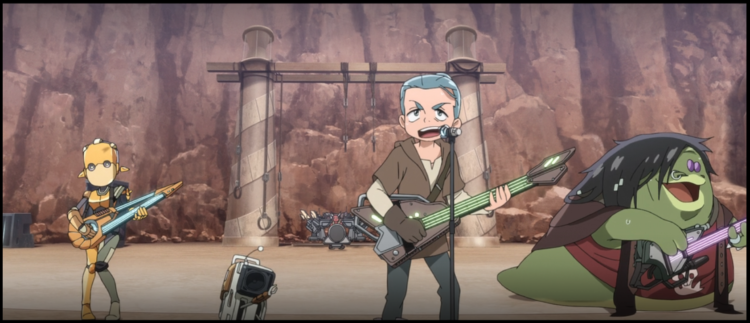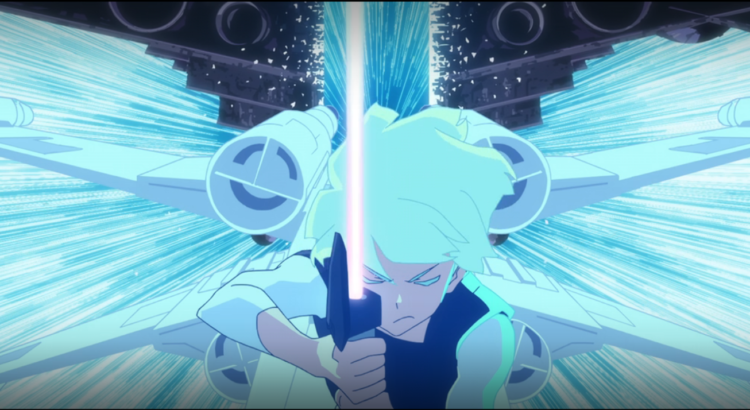Since Disney+ launched, one of its biggest selling points has been exclusive Star Wars media released directly to the platform. Starting with The Mandalorian, Star Wars launched its parent companies into the streaming era, and after its wild, runaway success, a green light went up for a number of Star Wars projects that otherwise might never have been given that go-ahead. One of those projects, and perhaps the most unusual and niche of them all, is Star Wars: Visions. A limited series of standalone episodes, each produced by one of seven different Japanese animation studios and telling an all-new story, a project like Visions would not have been possible previously, except maybe as a direct-to-home-video release, but thanks to streaming it was released to a platform that is already the home of major streaming flagship shows like the aforementioned Mandalorian or The Clone Wars.
What this article is going to broach are the elements that Visions brought to the table that would be welcome and wise to take further to the wider universe of Star Wars media at large. There are many different ideas, theories and other factors that could be considered here, but one that we will not get into is how Visions’ existence as media that is foundationally Japanese affects its place within the winding cultural miasma that Star Wars has always been, and how Star Wars can continue to draw from this well in ways that aren’t appropriative. Emma Candon, author of the Visions tie-in novel Ronin, dug into this idea far more thoroughly and with more insight than we would be able to here, so please check out her Twitter thread in the link below for more thoughts on this topic.
Setting that where it is, here are some more ways that Star Wars as a media franchise can learn from what the creators of Visions have produced.
A diversity of creators is a good thing
This one may go without saying, but I would be remiss not to mention it. Visions has provided some of the most energetic, dynamic and emotional Star Wars storytelling that has been created in years, and a good portion of the credit for that goes to the fact that the people telling these stories, from the writers to the directors to the animators themselves, are all new to the franchise and don’t hail from an American production studio. Being new to the creative energies of the franchise and coming to work within the universe from outside of Hollywood, Pinewood Studios or Skywalker Ranch, every short in Visions crackles with personality and culture and gives Star Wars itself new life. Not all of the stories Visions tells tread new ground, but all of them feel fresh and different because they’re told and presented differently than we’ve ever seen before.
Visions is in a unique place in that regard because it arose as a very purposeful project on Lucasfilm’s table: to have some of the best-known animation studios of Japan bring their own unique styles, themes and creative thumbprints to Star Wars. While Japanese animators have worked on Star Wars before — such as Atsushi Takeuchi, an animator on projects like Ghost in the Shell, working on The Clone Wars — Visions was born within the studios themselves (aside from localization such as subtitling and dub work). Lucasfilm, rather than simply hiring a studio such as Trigger or Kinema Citrus to animate a story already written by an in-house LFL writer, gave each studio free rein to first write whatever stories they wished, and then animate them in the way they felt best.

With that freedom, each studio and creative team could tell the stories they wanted in the way they felt was best, be they exciting, dramatic, romantic, melancholic, or just fun. Because they did not feel bound by studio oversight or pressure to adhere to a certain model of story or a certain artistic style, we have a nine-entry anthology where each entry is unique from anything in Star Wars previously, as well as being unique from each other. Visions’ great strength is its personality and individuality amidst the sea of other Star Wars media, and it gains both of those things by embracing the personality and individuality of each of the creative teams working on it. The more Star Wars is willing to embrace unique teams and talents and let them tell stories in the way they want to tell them, to see Star Wars through different people’s eyes, the more the franchise as a whole will continue to grow and flourish.
Economy in storytelling is important
It takes effort and skill to create a story that manages to leave its audience both satisfied and still wanting more. Even more difficult is to have economy in that storytelling, to be able to tell a quality story with memorable characters, moments, events and scenes within a specific, short time frame. Most stories nowadays are exercises in excess: movies are soaring upward in length, budget and in scope; sprawling TV or streaming series cover many seasons and often lead to spinoffs, sequels or prequels; video games demand dozens if not hundreds of hours to reach their conclusions; novels double as doorstops in good Tolkienian fashion; comic books build storylines on decades of obscure knowledge and trivia. It’s rare to encounter a story in any medium that believes in doing more with less rather than indulging itself in its own ideas.
This is a place where Visions proves itself an exception. Each episode of Visions clocks in at under twenty-five minutes, and most are fewer than twenty, yet each manages to tell a complete story within that time frame. None of them require a tie-in novel or spinoff TV show to flesh out their characters or setting, each manages to give the audience enough to draw them in, to make them cheer or boo or laugh or cry, and then rolls the credits with a satisfying swell of music. That’s not to say tie-ins to Visions can’t exist at all, the aforementioned novel Ronin being a direct tie-in to the episode “The Duel”, but the point isn’t the existence of the tie-in so much as the reliance on it.
A common criticism of the Disney-era movies is an over-reliance on the franchise as whole, where plot or character details that the films don’t explore or leave on the cutting room floor are subsequently picked up in a novel or comic book, turning those media into required texts for those wanting to get the “full story”. Visions doesn’t have this issue. Each story in Visions stands on its own, telling a story within its runtime by trimming away anything that might be considered an excess—often to the point of characters not being given names while on screen—and focuses on visuals, actions, and emotions, cruising through their runtime with beats the audience can grasp and follow despite not having an hour’s worth of setup, and hitting conclusions that feel satisfying without having overly drawn-out denouements.

The calls for Visions to have sequels or tie-ins or other explorations of its characters and worlds don’t stem from any of its stories lacking essential details, they stem from the fact that the audience simply wishes there was more. Accustomed as we as Star Wars fans are to everything being a part of a massive saga with tie-ins to the tie-ins and backstories for every character with a half-second of screentime, Visions’ dearth of minutia is like a spring breeze: warm, pleasant, and then gone without overstaying its welcome. We are left wishing for more, as a good story should leave us. Whether that happens at some point in the future remains to be seen, but it would be a possible bonus rather than being essential.
Not every story has to be about THE story
This is more of a controversial point, and has been a buzzy topic for a long time amidst Star Wars fan circles: how much, if at all, do parts of Star Wars need to tie back into the larger mythical arc of the saga? Do characters from the movies need to show up in order to make it “feel like Star Wars”? Or is an overreliance on existing elements causing the universe to feel too small? It’s a heady topic and there is not a single right answer; some references and appearances will feel earned and warranted to certain parts of the fandom and feel egregious and forced to others. But with the most recent major franchise installments like The Mandalorian and The Bad Batch tying in very closely to other media along their runs, it’s not a topic that’s likely to go away anytime soon.
Into this discussion steps Visions, and the point at which it lands is an interesting one. Visions does use existing characters, locations and other elements in some of its installments, while others are entirely original, so unlike with the previous points, where Visions is contrasted as a whole against other Star Wars media, here we can contrast Visions against itself. Is “Tatooine Rhapsody” a lesser episode than “The Duel” because it takes place on, well, Tatooine? Does the presence of Boba Fett and Jabba the Hutt make the story feel smaller or less original compared to “The Village Bride” and its entirely original cast? Again, there is no single right answer to any of these questions, and different readers of this article will have different opinions for all of them.

But here is where the contrast against the rest of the franchise is still important. Each episode of Visions, whether using existing elements of the universe or being entirely original, tells its own story. Each episode has their protagonist undergoing their own arc, mythic or otherwise, without there being a need to tie them in closer to the franchise overall. And a large part of this is the disregard for the albatross-around-the-neck that is the capital C Canon of Star Wars as a whole. Each story can exist in its own version of the Star Wars universe without having to conform to the needs of the stories that come earlier or later in the timeline. Because as far as each episode of Visions is concerned, there are no other stories in the timeline, there is only this story. And it can be as big or small as they wish, spanning the whole galaxy or just a single town on a single planet.
It’s remarkable that each episode of Visions, tying in as little or as much as it does to the rest of Star Wars’ vast history, still feels fundamentally like Star Wars. And it shows the resilience of the beating heart at the center of the franchise, how it isn’t limited to a certain set of characters, art style or even language. Visions is well named, in that each episode captures a vision of Star Wars that is different and unique, yet still remains true to the core of what we’ve all come to love about it. Visions is fun, emotional, passionate and sincere without taking itself one hundred percent seriously, and there is plenty to be taken away from it and back to the franchise as a whole to help breathe creative life into things that might otherwise become rote or stale.


This is perfectly said. I don’t know what the overall response looks like to Visions, since a lot of people don’t even take notice of animated fare, but I hope the reaction has been enough to make Disney realize that they can produce something without a member of the OT cast making a cameo.